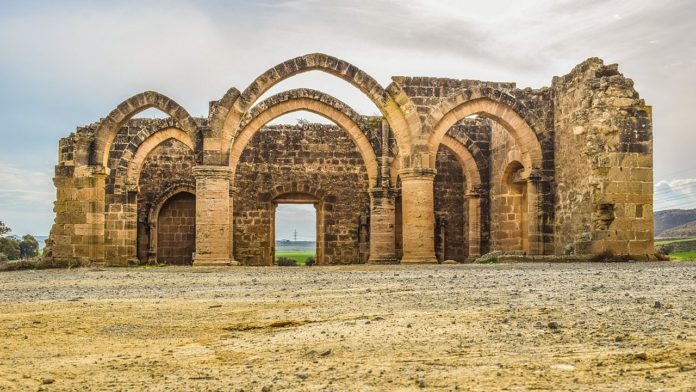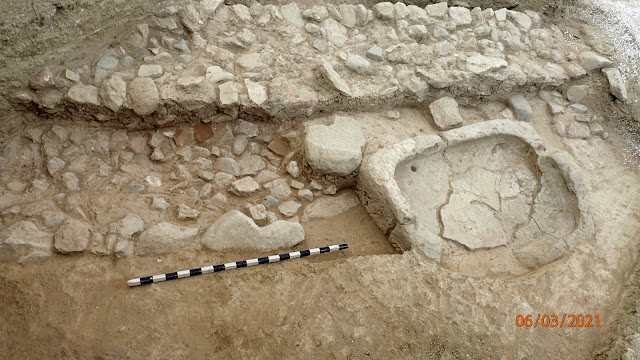Information
Copper Pendant, Workshops Found at Agios Sozomenos Site on Cyprus
Cyprus’ Department of Antiquities recently announced the results of the archaeological excavation season of 2021 at Agios Sozomenos, the site of a Late Bronze Age settlement.
A copper pendant, other copper objects and an extensive system of workshops were unearthed there this past year under the direction of the former Curator of Αntiquities, Dr. Despina Pilides.
There have been a number of archaeological excavations near the village over the years, including her project, which started in 2016 and is focused on remains from the Late Bronze Age.
This season’s work clarified the plan of the architectural remains of the workshops which were uncovered in previous years.
Agios Sozomenos site of Bronze Age settlement, pirate raids, saint’s miracle
The project included the location of possible new sites dating back to the Late Bronze Age in the entire region of Agios Sozomenos. The archaeologists’ survey was followed by excavation of the forts at Barsak and Nikolides in order to understand the relationship between them.
This work was followed by further excavations of the complex of workshops at the foot of Barsak at Djirpoulos and the storage building located on a small hill at Ampelia.
This past year’s dig involved the removal of thick layers of earth, including what were once mud bricks, and a layer of a mixture of earth mixed with plaster, which might be proof of the collapse of a roof. After they were cleared away the archaeologists found the wall foundations of the entire complex.
Bronze-Age Agios Sozomenos site destroyed completely, abandoned
They determined that some of the older walls had been reutilized and the rooms were generally enlarged in a later phase of reconstruction.
During that time, there were two large rectangular rooms, with the researchers discovering a great deal of scattered material, denoting that these places were once workshops. A large room was unearthed which had an entrance on the northeast, possibly to the street.
Both erect and fallen stone slabs at the site indicate that there must have been a stone cistern in the interior, which had been completely dismantled, perhaps like the one found in a good state of preservation in the SE part of the complex.
Large quantities of unworked gypsum slabs were also found in this area, as well as different kinds of stones, which the archaeologists say obviously had been brought in from elsewhere for use in the workshops. Traces of clay on the floor may indicate the presence of a hearth, and a small pit lined with stones supported the base of a large storage jar.
On the exterior of what the researchers call Wall 804, a large stone trough was found, preserved almost completely intact, measuring 1.20 meters (3 feet) in length and 1 meter wide; only the eastern side was broken. A drainage hole on its west side indicates that it may have been used as a water trough.
Part of a stone mold was found, as well as fragments of pithos, with relief decoration in parallel ridges. Some shards decorated in White Slip II, as well as fragments jugs in Plain White Ware, were also found by the archaeologists, alongside other cookware.
The archaeologists also uncovered some organic remains at the site, including an olive pip and other objects which were sampled for analysis, including animal bones and teeth.
Unfired clay and ceramic ware that was unearthed close to Wall 804 indicate that this part of the workshop complex was used for the production and firing of ceramics. Charcoal was collected from various parts of the complex and there may have been several hearths at various locations which have not been preserved.
Below the base of an upturned pithos, a copper pin, another small fragmentary copper object, a pointed stone tool and a stone weight were also found. A circular depression nearby may have held the pithos in place at one time.
Stone grinders, mortars, saddle querns, pieces of stone vats, slag and small fragments of copper objects as well as a copper pendant were found in a small area adjoining Wall 851. Gaming stones, which had for the most part been repurposed, were also noted, as well as some sling stones and stone weights.
The archaeologists concluded that in the later phase of the Late Bronze Age settlement there were complexes consisting of adjoining rooms with evidence for workshop activities in them, accessed by a street on the north side and, perhaps, on the west side of the SE complex.
It is evident that the last phase showed that there had been widespread destruction before the settlement’s abandonment, which seems to have been even worse in the western part of the complex.
Agios Sozomenos now deserted once again in modern era
Agios Sozomenos (Greek: Αγιος Σωζόμενος) is a deserted village in the Nicosia District of Cyprus, close to the Green Line delineating the border with the occupied northern part of the island, near Potamia.
The village is known for the Byzantine cave chapel dedicated to the hermit saint known as Sozomenos, who is credited for saving the population from pirates centuries ago.
The never-completed Latin-rite church of Saint Mamas, with its many soaring arches, is the most iconic of all local buildings still extant. It dates back to the time of Latin rule on Cyprus, between the 1300s-1500s.
The village itself was abandoned in 1964 due to the unrest that took place between Greek Cypriots and Turkish Cypriots there. In recent years, Agios Sozomenos has also become a popular attraction for visitors.
The church of Agios Sozomenos, at the site of the hermit’s cave, stands just 300 meters from the center of the village. The cave has been closed off by a wall since 1912, when a British court awarded control of the chapel to the Greek Cypriot inhabitants of the village.
The church includes a number of wall paintings depicting scenes from the life of Saint Sozomenos, which some believe date back to the to the 14th century. (An earlier layer from the 10th century were taken to the Byzantine Museum in Nicosia.) Details of the saint’s life are unknown, as no synaxarium survives from before 1780, but St. Sozomenos is likely to have lived in the 10th or 11th centuries.
The paintings depict miracles attributed to him. After his death, a cult developed around his healing powers, which led to the development of the cave as a church and building up a village around it.
The cave also has niches with icons and candles; an agiasma (sacred water fountain); and a recess for burial, although the saint’s remains have been removed.
The scholarly consensus is that the Latin-rite church of St. Mamas was never completed, as is evidenced by unfinished stonework and other architectural details. It features two arcosolia for the burial of wealthy donors.
Category: English
News
Information
Key words:


